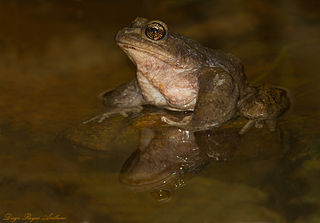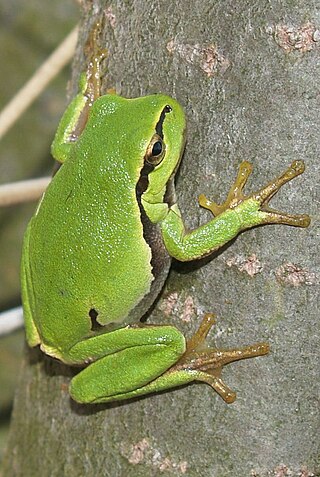
Tepuihyla, commonly known as Amazon tree frogs or Tepui tree frogs, is a genus of frogs in the family Hylidae found in mountains of eastern and south-eastern Venezuela and Guyana, and likely in adjacent Brazil. A tepui is a table-top mountain characteristic of the Guiana Highlands.
Oedipina complex, commonly known as the Gamboa worm salamander, is a species of lungless salamander found in western South America from Costa Rica to western Colombia and north-western Ecuador. This species inhabits humid tropical lowland forest where it can be found on the ground, and on bushy vegetation, logs and rocks. It can also be found on forest edges, but it does not survive in degraded areas. Deforestation is a threat to this species.

Tomopterna is a genus of frogs from sub-Saharan Africa.
Nymphargus mariae, commonly known as Maria's giant glass frog, is a species of frog in the family Centrolenidae. It is found in the cloud forests of the Serranía de Sira, Huánuco, Peru and in Ecuador. A population endemic to Ecuador was previously considered to be a distinct species, Nymphargus puyoensis, but is now classified as a junior synonym.
Warren's tree frog is a species of frog in the family Hylidae found in Guyana and possibly Brazil and Venezuela. Its natural habitats are subtropical or tropical moist montane forests, rivers, freshwater marshes, and intermittent freshwater marshes.
Tepuihyla exophthalma is a species of frog in the family Hylidae. It is native to Guyana and Venezuela in South America.
The Monte Duida tree frog is a species of frog in the family Hylidae. It is endemic to Venezuela and only known from the Cerro Duida, its type locality in the Amazonas state of southern Venezuela. Its natural habitat is montane tepui vegetation, specifically forest and shrubs adjacent to rivers, streams, and peat bogs. No significant threats to this species occurring in the Duida-Marahuaca National Park are known.
Ayarzaguena's tree frog is a species of frog in the family Hylidae found in Venezuela and possibly Guyana. Its natural habitats are subtropical or tropical high-altitude shrubland, swamps, freshwater marshes, and intermittent freshwater marshes.
Tepuihyla luteolabris is a species of frog in the family Hylidae endemic to Venezuela where it can be found on a number of tepui. Its natural habitat is high montane tepui vegetation. Reproduction takes place in rivers.

Tepuihyla rodriguezi, also known as the Rodriguez's Amazon treefrog is a species of frog in the family Hylidae found in southeastern Venezuela and Guyana.

The Kaieteur Tepui treefrog is a species of frog in the family Hylidae endemic to Guyana. This species is known only from the type locality, which is given as "Kaieteur Falls, 366 m asl, Mazaruni-Potaro District, Guyana". It might occur more widely.

Alsodes nodosus is a species of frog in the family Alsodidae endemic to central Chile; records from Argentina are not considered valid.
Ptychadena uzungwensis is a species of frog in the family Ptychadenidae. It is found on the East African Plateau in Rwanda, Burundi, and Tanzania in the north and then southward to eastern Democratic Republic of the Congo, northern Angola, Zambia, Malawi, Zimbabwe and uplands of Mozambique. Its common names include Udzungwa ridged frog and Udzungwa grass frog, where "Udzungwa" may also be written Uzungwa, following the spelling that Arthur Loveridge used in the species description for the Udzungwa Mountains, the type locality.
The rough sand frog is a species of frog in the family Pyxicephalidae. It is found in Angola, the Democratic Republic of the Congo, Namibia, Tanzania, Zambia, and Zimbabwe, and possibly Malawi and Mozambique. Its natural habitats are dry savanna, moist savanna, freshwater marshes, and intermittent freshwater marshes.

Hylinae is a large subfamily of "tree frogs", family Hylidae.

Josefa Celsa Señaris is a Venezuelan herpetologist. She has published information about frogs and she has identified new genera and species. Señaris is the director of the La Salle Foundation's Natural History Museum in Caracas.
Tepuihyla obscura is a frog in the family Hylidae endemic to Bolivar State in Venezuela. Scientists have seen it near summits in the Chimantá Massif, between 1800 and 2600 meters above sea level.
Tepuihyla shushupe is a frog in the family Hylidae. Scientists know it exclusively from its site of collection, the headwaters of the rivers Ere and Campuya near the Colombian border within Peru. They collected the sample 145 meters above sea level.






